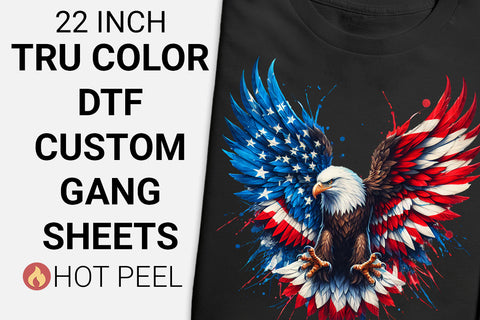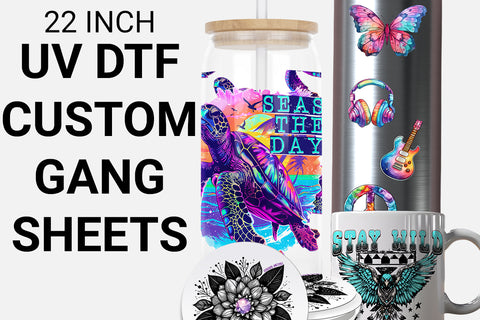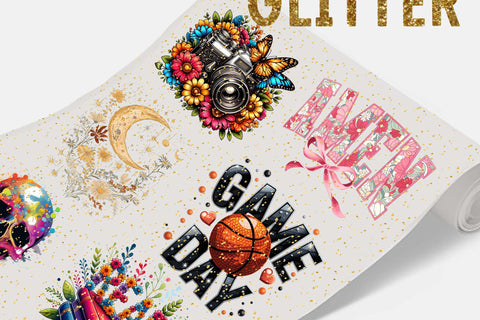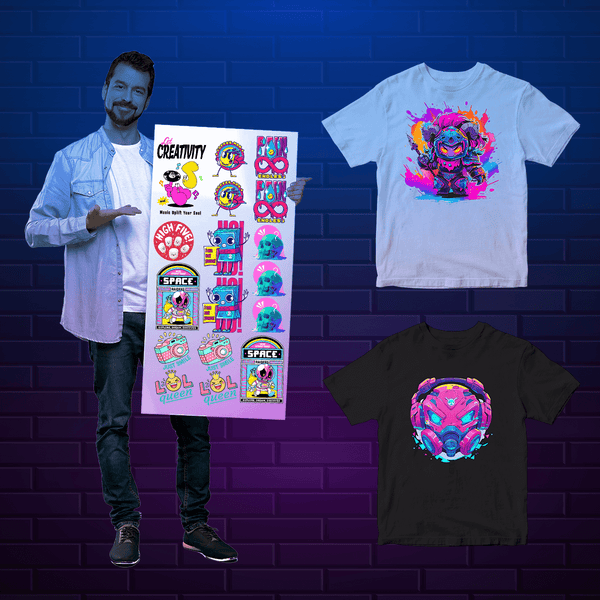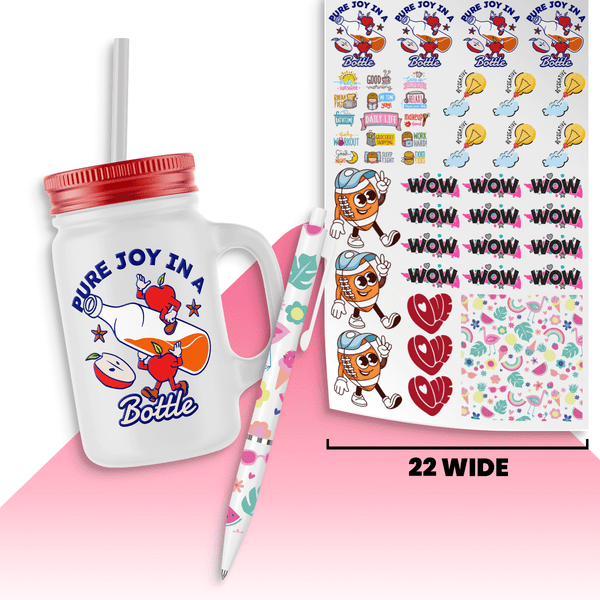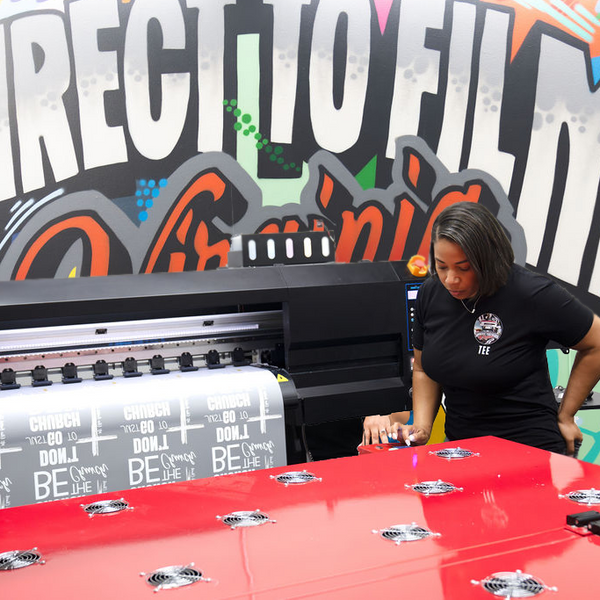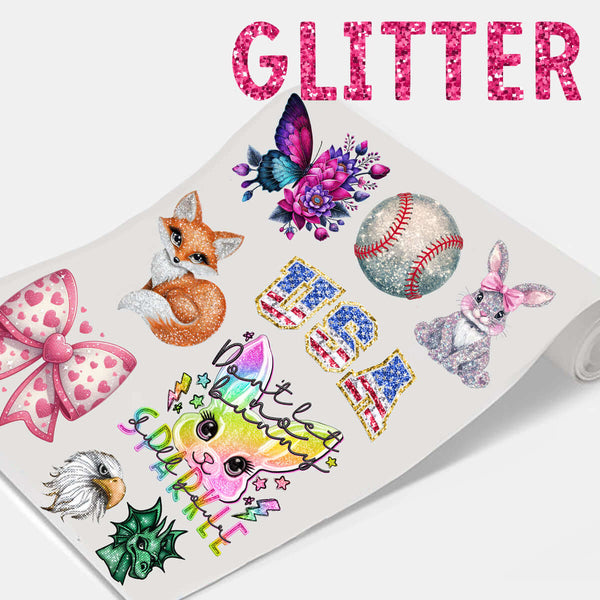DTF printing presents an innovative approach that is transforming the textile industry. Businesses succeed, and people enjoy the customization due to DTF’s accuracy in prints, durability, versatility, and affordability. In this guide, you will learn everything about DTF printing explained in simple terms, whether you are a beginner, starting up a business, or just an ordinary person looking to improve your knowledge. Let's slide into the details!
What is DTF Printing and How Does DTF Printing Work?
This is a famous but professional printing technique that works by transferring designs from software to PET film by using a DTF printer. This method delivers high-quality and durable images with ease compared to other printing methods. Plus, this method works with various fabric types from cotton, polyester, and blends, to nylon, and more.
Equipment and Tools Required for DTF Prints
Here are the essential tools that you will need to get the high-quality DTF prints:
-
The DTF printer is equipped with CMYK (Cyan, Magenta, Yellow, Black) inks and white ink capabilities.
-
Transparent PET Films heat-resistant films are used as the medium for transferring designs.
-
High-quality water-based inks designed specifically for DTF printing.
-
Hot-melt adhesive powder to bond to the material during heat pressing.
-
Heat press machine to transfer the design from the film to the fabric.
-
A curing oven (optional) is used to cure the adhesive powder on the film evenly.
-
Adobe Illustrator or Photoshop software to prepare the designs.
-
Gloves to handle the films without leaving fingerprints.
Step-by-Step Process of DTF Printing
For your query, what is the process of DTF printing, here is the step-by-step process:
Step#1: Design Creation
Pick up the desired software like Photoshop or CorelDRAW to create a design of your choice with a high-resolution format (preferably PNG) to ensure clarity. Ensure the design uses CMYK color settings for accurate color reproduction. Moreover, add a white underlayer in the design for vibrant prints on dark fabrics.
Step#2: Film Printing
Now, load the PET film into the DTF printer, which uses 9 color ORGB + CMYK inks for the main design and a layer of white ink beneath it. Then, adjust the printer settings to ensure an even application of white ink. Too much white ink can cause the design to peel, while too little may result in faded prints.
Step#3: Adhesive Powder Application
It's time to sprinkle the hot-melt adhesive powder evenly across the freshly printed design on the PET film. Remove any excess powder for consistent and uniform coverage.
Step#4: Curing the Adhesive
In this step, place the adhesive-coated film in a curing oven or under a heat source at 160°C-180°C for 2-3 minutes. This ensures the adhesive melts and forms a smooth, sticky layer on the film.
Step#5: Heat Transfer
Position the cured film on the fabric or material with the design facing downward, place the fabric and film under the heat press, and set the temperature (typically 170°C-180°C) and pressure. Press for 10-15 seconds, depending on the material and adhesive used.
Step#6: Peeling the Film
Let the fabric cool before peeling the film off slowly. After peeling, re-press the design for 5-10 seconds to enhance durability and smoothness.
Advantages of DTF Printing (Pros)
Versatility Across Fabrics
This printing type is highly compatible with a wide variety of materials like polyester, cotton-poly blends, nylon, leather, and more. Thus, you can make various products like custom t-shirts, caps, tote bags, or jackets.
Durable & Ensure Longevity
DTF prints are durable and quality remains the same even after multiple washes without cracking and peeling. The use of hot-melt adhesive creates a strong bond between the material and it prevents the prints from cracking.
Cost-effective for Small and Large Orders
There are no pre-treatment or screen-making requirements, only you need to buy basic tools that are initially costly but later on, it provides a great return on your initial investment which makes this method cost-efficient.
High Color Quality and Vibrancy
DTF printing uses CMYK and white inks to achieve bold, vivid colors, even on dark fabrics. The inclusion of a white ink base ensures that the design’s colors pop against any background. The method also supports complex designs, gradients, and fine details.
Eco-Friendly Ink Usage
DTF inks are water-based and generally eco-friendly with less impact, which aligns with the growing consumer demand for sustainable practices. The efficient use of materials also reduces waste compared to traditional methods.
Easy-to-Use Technology
The process of DTF transfers is simple and has minimal learning requirements. With the right equipment and training, even small businesses and startups can adopt this technology to deliver professional-quality products.
Disadvantages of DTF Printing (Cons)
Maintenance of Equipment
It is important to maintain your DTF equipment, especially the printer when using white ink because it settles and clogs the printer nozzles. You need to clean the printer frequently and avoid downtime.
Adhesive Powder Handling
Hot-melt adhesive powder is an important component of DTF printing, but its application can be messy and inconsistent without proper tools like a powder shaker. An uneven powder application can result in a defective design. So, the curing process requires careful temperature and timing adjustments to avoid issues.
Initial Investment Costs
For smaller orders, DTF printing is more cost-effective than traditional methods, but the initial investment in a DTF printer, PET films, curing devices, and other supplies can be expensive. A small business may find this upfront cost prohibitive.
Slower Process for Large Orders
DTF is excellent for small batches or custom orders, but it is sometimes time-consuming for large-scale production compared to screen printing. The printing and curing process for each sheet of PET film adds to the overall production time and makes it less efficient for mass production.
How Much Does DTF Equipment Cost?
The cost of DTF printing equipment varies and is based on printer size, features, and included accessories. Here is an overview of the price ranges for different types of DTF printers. A4 DTF printers are entry-level models which cost around $1,749 to $2,995.
A3 DTF printers offer a larger print area and are ideal for medium-sized businesses, with prices ranging from $2,298 to $4,695. 24-inch DTF printers are designed for larger production needs, and they are priced between $10,995 and $15,995.If you purchase DTF printer bundles then such packages that include additional equipment and supplies can range from $3,795 to over $24,000, which depends on the components and printer specifications.
DTF Printing Transfer vs. Other Printing Methods
|
Feature |
DTF Printing |
DTG (Direct-to-Garment) |
Screen Printing |
Sublimation Printing |
Heat Transfer Vinyl (HTV) |
|
Material Compatibility |
Works on a wide range of fabrics (cotton, polyester, blends, leather, etc.) |
Limited mostly to cotton and cotton blends |
Primarily cotton or fabric blends |
Requires polyester or polymer-coated surfaces |
Limited to certain fabric types |
|
Durability |
Highly durable, resistant to cracking and fading |
Durable but may fade over time with frequent washing |
Extremely durable but prone to cracking over time |
Excellent durability, resistant to fading |
Moderate durability; may peel or crack |
|
Color Vibrancy |
Vibrant colors with CMYK + white ink |
Vibrant colors but struggles on dark fabrics without pre-treatment |
Bright colors but limited to fewer gradients |
Limited vibrancy unless used on white surfaces |
Decent colors but lack detail and gradients |
|
Cost Efficiency |
Cost-effective for small and large batches |
Expensive for small runs; cost-effective for large designs |
Cost-effective for large orders; expensive for small batches |
Affordable for small items but expensive for non-polyester |
Affordable for small-scale designs |
|
Detail Precision |
High precision for intricate designs and gradients |
High precision, especially on light fabrics |
Moderate precision struggles with fine details |
Moderate precision but limited for gradients |
Limited detail; best for simple designs |
|
Setup Time |
Minimal setup required |
Requires pre-treatment of fabric and time-consuming setup |
Lengthy setup due to stencil preparation |
Minimal setup |
Quick setup |
|
Speed for Large Orders |
Slower for mass production |
Slow, especially for multi-color prints |
Fastest for bulk orders |
Moderate speed |
Moderate speed |
|
Initial Investment |
High (DTF printer, PET films, curing tools) |
High (DTG printer and pre-treatment machine) |
Medium (screen, ink, and exposure equipment) |
Low to medium (sublimation printer and heat press) |
Low (heat press and vinyl cutter) |
|
Eco-Friendliness |
Eco-friendly inks but adhesive powder may pose challenges |
Eco-friendly inks but water usage can be high |
Not eco-friendly due to chemical-based inks |
Eco-friendly inks, but limited material usage |
Vinyl material adds to waste |
|
Fabric Pre-Treatment |
Not required |
Required for optimal results |
Not required |
Not required |
Not required |
|
Versatility |
Highly versatile for various surfaces and textures |
Limited to flat, untreated fabrics |
Best for flat, large designs |
Limited to polyester or coated surfaces |
Limited to flat and simple designs |
|
Learning Curve |
Moderate, easy to learn with some practice |
Steep; requires mastery of pre-treatment and printing techniques |
Steep due to complex stencil preparation |
Easy for beginners |
Easy for beginners |
Key Takeaways
-
DTF Printing stands out for its versatility and vibrant output and is ideal for custom orders on a variety of materials.
-
DTG is great for cotton garments but struggles with dark fabrics unless pre-treated.
-
Screen Printing is the go-to for large-scale production but requires more setup and isn't ideal for intricate designs. See the difference.
-
Sublimation is excellent for polyester but limited to light-colored surfaces.
-
HTV is best for simple, small-scale designs but lacks the detail and durability of other methods.
Ending Note: The Future of DTF Printing
Direct-to-film printing is becoming a backbone of the textile industry due to all the mentioned reasons. The future of DTF printing is incredibly promising. As technology continues to advance, we can expect improved equipment with more efficiency, eco-friendly innovations in biodegradable films, and integration with AI tools to streamline the design process and affordability.
For businesses, investing in DTF printing today means staying competitive in the future. Businesses position themselves to take advantage of the endless opportunities this transformative technology offers.
FAQs
How much does DTF printing cost?
The initial setup with a basic DTF printer, including the printer, curing oven, heat press, and other essentials, can range from $2,500 to $10,000 or more for high-end industrial machines. PET films cost around $1 - $3 per sheet, and adhesive powder and ink vary based on the brand but typically range from $40- $100 per kilogram. Moreover, for an average design of A4 size, the cost is around $1 - $3 per transfer, including ink, powder, and film.
What to do if I need to start a DTF printing business?
To start a DTF printing business, you’ll need basic equipment like a DTF printer, PET films, inks, adhesive powder, heat press, premium designing software, and a clean workspace to execute your business.
Can I print multi-colored designs with DTF printing?
Absolutely! DTF printing excels at producing vivid, multi-colored, and highly detailed designs. It supports CMYK color models, enabling full-spectrum prints that maintain vibrancy on both light and dark fabrics.
Can I print on pre-made garments with DTF?
Yes, you can buy pre-made garments like T-shirts, hoodies, hats, and more to apply DTF prints.
How to maintain a DTF printer?
Regular maintenance ensures consistent print quality:
-
Clean the print heads weekly.
-
Use the printer regularly to prevent ink clogs.
-
Replace consumables (like films and powder) as needed.
-
Keep the workspace clean to avoid dust affecting the adhesive.
